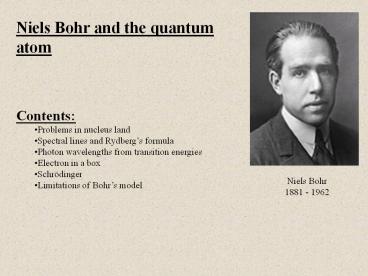Niels Bohr and the quantum atom - PowerPoint PPT Presentation
1 / 14
Title:
Niels Bohr and the quantum atom
Description:
Niels Bohr and the quantum atom Contents: Problems in nucleus land Spectral lines and Rydberg s formula Photon wavelengths from transition energies – PowerPoint PPT presentation
Number of Views:308
Avg rating:3.0/5.0
Title: Niels Bohr and the quantum atom
1
- Niels Bohr and the quantum atom
- Contents
- Problems in nucleus land
- Spectral lines and Rydbergs formula
- Photon wavelengths from transition energies
- Electron in a box
- Schrödinger
- Limitations of Bohrs model
Niels Bohr 1881 - 1962
2
Problems with the Rutherford Atom
- Acceleration/Radiation
- Spectral Lines
TOC
3
- Spectral lines
- Energy from excited atoms
- demo
Rydbergs Formula (FYI) 1/? R(1/22 - 1/n2), n
3, 4, ...(Balmer) (Visible) 1/? R(1/12 -
1/n2), n 2, 3, ...(Lyman) (UV) 1/? R(1/32 -
1/n2), n 4, 5, ...(Paschen) (IR) (R 1.097 x
10-7 m-1)
H
He
Sun
TOC
4
Bohrs Quantum Atom
- Only certain orbits are allowed stationary
states - Electron transitions create photons
1/? R(1/22 - 1/n2), n 3, 4, ...(Balmer)
(Visible) 1/? R(1/12 - 1/n2), n 2, 3,
...(Lyman) (UV) 1/? R(1/32 - 1/n2), n 4, 5,
...(Paschen) (IR)
5
Example What is the wavelength of the first
Lyman line?
The first Lyman line is a transition from -3.4 eV
to -13.6 eV, so it releases 10.2 eV of energy. A
photon with this energy has this wavelength E
(10.2)(1.602E-19) 1.63404E-18 J E hc/?, ?
hc/E (6.626E-34)(3.00E8)/(1.63404E-18)
1.21649E-07 m 122 nm
6
Whiteboards Bohr Photons 1 2 3 4
TOC
7
What possible photon energies can you get from
these energy levels? (there are 6 different ones)
-5.0 eV
-6.0 eV
-9.0 eV
-14.0 eV
1, 4, 9, 3, 8, and 5 eV
8
What is the wavelength of the photon released
from the third Lyman spectral line (from -.85 to
-13.6 eV)?
E hf hc/ ? E -.85 - -13.6 12.75 eV E
(12.75 eV)(1.602E-19J/eV) 2.04E-18J ? hc/E
97.3 97 nm
W
97 nm
9
What is the wavelength of the photon released
from the second Balmer spectral line (from 0.85
to -3.4 eV)?
E hf hc/ ? E -0.85 -3.4 2.55 eV E
(2.55 eV)(1.602E-19J/eV) 4.09E-19J ? hc/E
487 490 nm
W
490 nm
10
An 102.5 nm photon is emitted. What is the
energy of this photon in eV, and what transition
occurred?
E hf hc/ ? (6.626E-34)(3.00E8)/(86.4E-9)
2.30069E-18 J (2.30069E-18 J)/(1.602E-19) 12.1
eV This could be the second Lyman line
W
12.1 eV
11
Electron in a box
- Why are only certain orbits allowed? (Demo)
TOC
12
Try this What would be the kinetic energy of an
electron in the ground state of a box that is
about 0.1 nm in length? me 9.11x10-31 kg
Ek 12(6.626E-34)2/(8(9.11E-31)(.1E-9)2)
6.02413E-18 J ( 38 eV)
W
6 x 10-18 J
13
Schrödinger and the quantum atom
Schrödinger solves ? for hydrogen atom The
electron is represented by a wave Can only be
solved for H, singly ionised He
TOC
14
Limitations of Bohrs model
- Works well for H, but doesnt even work for He
- Did not explain
- Spectral fine structure
- Brightness of lines
- Molecular bonds
- Theory was not complete.
- But otherwise it generally kicked tuckus
TOC































